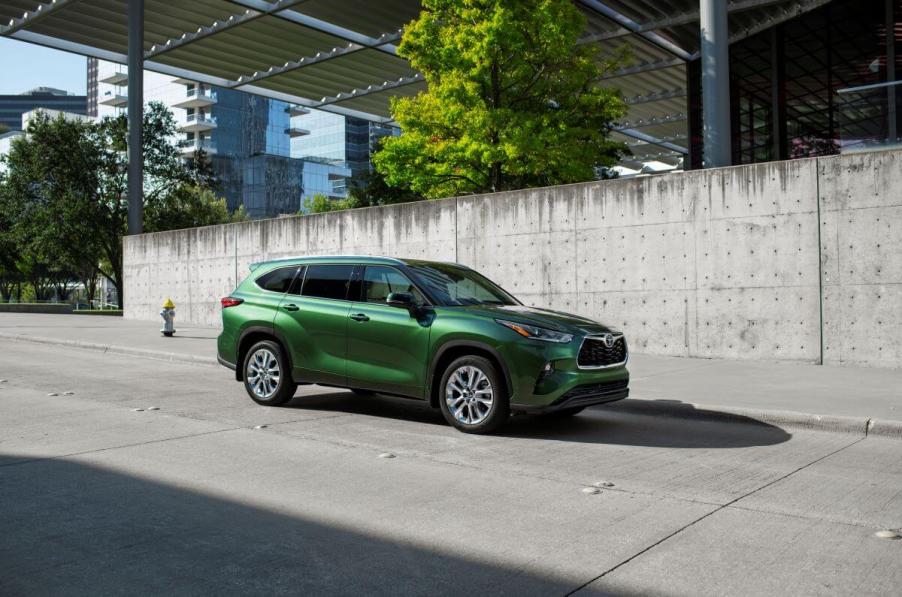
3 Ways the Toyota Highlander Is a Pioneer Among Midsize SUVs
People first caught a glimpse of the Toyota Highlander in 2000 at the New York International Auto Show as it was introduced for the 2001 model year. Little did we know just how much this Toyota vehicle would be a pioneer for midsize SUVs on the market. Let’s explore the three ways it changed the future of sport utility vehicles.
1. Inspiration for crossover SUVs

The Toyota Highlander midsize SUV debuted for the 2001 model year. While it wasn’t the first SUV to hit the market, it was one of the first to go against the truck platform-based vehicles, according to Cars.com. Built off the same chassis as the Camry sedan, the Highlander offered car-like handling, comfort, and smooth riding capabilities. Thus, the idea of crossovers and safe riding was born.
Toyota’s Highlander went through a few redesigns over the years. In 2004, a third-row option was introduced to the lineup of trims. Then, in 2014 the third-row seats were widened to expand passenger space from the original seven to being able to seat eight.
In 2008, the brand changed the platform and based the new generation on the Avalon sedan to create more interior space. The exterior styling was updated in 2011, 2014, 2017, and 2020. The 2017 model also added a new eight-speed automatic transmission.
2. The Toyota Highlander paved the way for hybrid powertrains
One of the most significant changes Toyota made with the Highlander was for the 2006 model year. This turned out to be pretty revolutionary because it was the first hybrid SUV to enter the market, according to Toyota. Plenty more would follow after that from other automakers.
The first hybrid powertrain combined an electric motor and a 3.3-liter V6 gasoline engine. For the AWD models, Toyota added a second electric motor to send power to the rear wheels. In 2011, the Highlander switched out the engine to a 3.5-liter V6 unit instead, according to Autotrader. This allowed it to get around 27 mpg in the city and 28 mpg on the highway.
In 2020, the brand switched to a 2.5-liter four-cylinder engine paired with an electric motor setup for the Toyota Highlander Hybrid. This enabled the Highlander Hybrid to get about 36 mpg in the city and 35 mpg when traveling on the highway. However, the all-wheel-drivetrain was no longer standard.
3. A huge step toward producing environmentally friendly vehicles
Toyota plans to pull out all the stops to obtain carbon neutrality for its brand. So far, it’s developed 10 hybrid models, two plug-in versions, battery-electric technology (for the new bZ4x), and the hydrogen fuel cell unit seen with the Mirai.
When it comes to earning a “Beyond Zero” badge, Toyota is introducing the second vehicle, the Grand Highlander, built with advanced technology to work toward a future of zero emissions. The first is the all-new Prius model.
The new Toyota Grand Highlander SUV will offer a hybrid max powertrain producing 362 hp and 400 lb-ft of torque. Paired with it will be a continuously variable automatic transmission, which will help the vehicle go from 0 to 60 mph in 6.3 seconds. It will come with standard AWD and Multi-Terrain Select, which offers Rock, Sand, Dirt, Mud, and Snow driving modes.
As for the cargo area, you can get up to 98 cubic feet of storage if you fold down the second and third-row seats. Other comfort features include a heated steering wheel, 1,500-watt power outlets, a hands-free liftgate, heated and ventilated front seats, and power-folding side mirrors.
The Toyota Highlander midsize SUV has been around for a while. In that time, it’s been a huge pioneer in the industry when it comes to introducing crossover technology, the first hybrid powertrain, and helping pave the way to the Beyond Zero badges.



